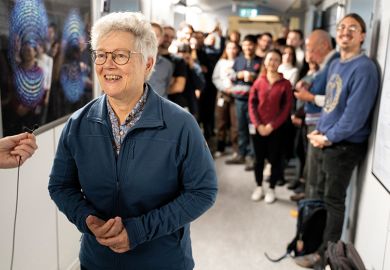Living physicists constitute a tribe, within which John Wheeler belongs to the clan of Bohr, as do many other physicists of his vintage. Other clans are those of Rutherford, Lawrence and Sommerfeld, all of whom populated chairs of physics with their descendants.
At Home in the Universe is a collection of lectures and essays, many reprinted from various journals over the decades, all connected in some way with quantum mechanics or its founders.
Deeply influenced by spending 1933-35 in Copenhagen, Wheeler became an admirer of Bohr and collaborated with him up to and after Bohr's escape from the Nazis and his involvement with the atom bomb. Admiration permeates the vignettes from Bohr's life that are reported by the author.
Wheeler also relates to Einstein, a majestic presence in Princeton, whose reluctance to bow to quantum mechanics is still weighed. Einstein found the everyday interpretation of the uncertainty principle distasteful; his mantra "Raffiniert is der Herr Gott, aber boshaft ist Er nicht" (Subtle is the Lord God, but not malicious) is carved into the mantelpiece in Princeton's Fine Hall. Einstein's frequent personification of Nature as the Deity has often been commented on. A good deal of the interest in Wheeler's essays turns on the reverent sociology of the physicists.
Bohr played a basic role in the development of quantum mechanics. The quantum and one of its manifestations, the photon, are familiar these days, but the implications are perplexing. Multitudes of high-school students understand Newton's law of gravitation, a non-trivial advance of widest import. Very few, if any, have grasped the impact of the quantum.
Light reaching us from a faint, distant star seems to become fainter and fainter with distance travelled, but since 1900 there has been Planck's quantum of action. For visible light this translates into a packet of energy, or photon, amounting to 3 x 10-12 ergs. Though this is small, the vastness of space ensures that a telescope can be far enough away from a faint star such that less than one photon is to be expected in the course of an observing session of, let us say, one hour's duration. On some nights a photon may be registered, but on others nothing at all from that star. Our radiation detectors, though sensitive, record nothing in between the discrete moments of registering something. The graphic picture of light waves dying away to barely perceptible ripples may be applicable when there are lots of photons, but the radiant energy, when faint, is detected in spatially and temporally confined packets, not in waves. This is a gross phenomenon of nature, as witnessed daily by the generation of electricity in silicon solar cells. A photon of red sunlight can pass through, but a blue photon possesses the energy necessary to release a conduction electron; to the naked eye the silicon looks conspicuously opaque.
So what! - so light is a wave motion consisting of a stream of corpuscles. Here is the rub. Since the waves are not what is directly observed, do they really exist? Should not a description of the physical world proceed from what is observable, namely the corpuscular photons? The more one thinks about this the stranger it seems, even leading to a well-established view that the wave phenomenon is called into reality only by the act of observation of a photon - quo facto, one can deduce something about a putative wave field.
On the view just mentioned, the past in general appears on the scene as a consequence of an act of observation, having no other independent reality. This unfamiliar, modern philosophical stance is exemplified by the Anthropic Principle, seriously considered at length by Wheeler.
The Anthropic Principle asserts that there is some connection between the parameters of the universe and the existence of consciousness; it expands the 17th-century view of God the Clockmaker who, having started the Universe running, left it alone: a modification of the God of the Old Testament who interacted with His creation as events unfolded. Newton's uncovery of the simple and inexorable law of gravitation, which explained the heavenly phenomena without recourse to the supernatural, and the contemporaneous development of planetary calculators and mechanical clocks, gave support to the clockmaker concept. Now, in response to the uncovery of the quantum and further cosmological insights, there is a trend to dispense with the clockmaker, but the mystery remains: a teleological sense that the universe exists for a purpose (us). Of course many physicists are comfortable with the notion that human life is an irrelevant, transitory flicker about which the "Universe" neither knows nor cares.
Although the term Anthropic Principle is itself recent, there are precursors, starting in 1919 with Hermann Weyl, who commented that the ratio of the electron radius to the electron's gravitational radius is of the order of 1040 and that the ratio of the radius of the universe to the electron radius might be similar. This coincidence was commented on by Eddington in 1923 and in 1938 by Dirac. By 1986 J. D. Barrow and F. J. Tipler had written The Anthropic Principle, remarking that if the fundamental dimensionless constants of physics differed by a few per cent one way or the other then man could never have come into being. There is more to this notion than can be discussed here; suffice it to say that Wheeler connects it with the puzzle of the quantum.
One such connection is revealed by the extraordinary extract: "Quantum mechanics has led us to take seriously and explore the . . . view that the observer is as essential to the creation of the universe as the universe is to the creation of the observer." Life on this view is not the inexorable, orthodox consequence of taking a universe with 1080 particles and letting it run for 1010 years - indeed Wheeler wonders whether this prescription for biological creation is on any better footing than the spontaneous creation of mice reported from earlier times. The evolution of conscious, observant beings, themselves composed of a subset of the "inanimate" material universe - a subset that (incredibly) is able to tackle the comprehension of the whole and increasingly to control the immediate environment - is accommodated by the Anthropic Principle. The indispensable role of the observer in defining a useful concept of reality leads to the astounding concept of genesis through observership.
Though a Big Bang several billion years ago is strongly indicated by the make-up of the atomic nuclei and the cosmological radiation, what led to a bang is a mystery likely to resist comprehension because the structure of space and physics then changed. Wheeler hopes that deeper insight may connect the mystery of creation with the mystery of the quantum. Photons are evoked by the observer; could genesis be induced by observership? This is pretty heady stuff, only a flavour of which can be conveyed here. The book does not aim to be an explanatory popularisation, but is rather on the groping edge of metaphysical thought about the origin and nature of the universe and the destiny of man. The themes have been polished on general audiences and, while it is true that ideas from astronomy, cosmology and physics are introduced freely, nevertheless unobtrusive background is often deftly supplied. There is no mathematics to daunt a reader. This is a marvellous book, full of gems.
Ronald N. Bracewell is emeritus professor of electrical engineering, Stanford University.
At Home in the Universe
Author - John Archibald Wheeler
ISBN - 0 88318 862 7
Publisher - The American Institute of Physics
Price - £21.50
Pages - 371pp
Register to continue
Why register?
- Registration is free and only takes a moment
- Once registered, you can read 3 articles a month
- Sign up for our newsletter
Subscribe
Or subscribe for unlimited access to:
- Unlimited access to news, views, insights & reviews
- Digital editions
- Digital access to THE’s university and college rankings analysis
Already registered or a current subscriber? Login



